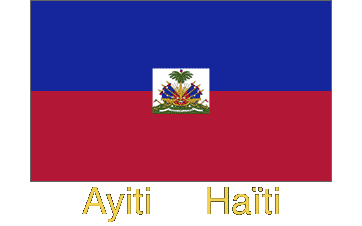Photos from Haiti
| Home | About | Guestbook | Contact |
HAITI - 1980

A short history of Haiti
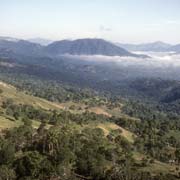
The Republic of Haiti, on the western part of the island of Hispaniola in the Greater Antillean archipelago, has a unique history. It was the first independent nation in Latin America, the first post-colonial independent Black-led nation in the world, and the only nation whose independence was gained as part of a successful slave rebellion. Its 10 million inhabitants are almost all descendants of those former slaves. Apart from the official French, they speak a unique language, Kreyòl Ayisyen or Haitian Creole, based mainly on 18th-century French with various other influences, most notably African languages (including some Arabic), Spanish and Taíno. Kreyòl has been recognised as an official language since 1961. The name Haïti is the French form of Ayiti (Land of high mountains), the indigenous Taíno or Amerindian name for the mountainous western side of the island. The country’s highest point is Pic la Selle, at 2,680 metres above sea level.

The island of Hispaniola was initially inhabited by the Taíno Arawak Indians, a seafaring branch of the South American Arawaks. The Taíno-Arawak population on Hispaniola was divided through a system of established cacicazgos (or caciques in French), tributary chiefdoms, with payment consisting of food grown by the Taíno. There are still Taíno cave paintings in the country, but no trace remains of the Indian population. The beginning of the end came with the landing of Christopher Columbus landed at Môle Saint-Nicolas on 5 December 1492, where he claimed the island for Spain. Nineteen days later, his ship, the Santa María, ran aground near the present site of Cap-Haïtien. Some of his crew founded the settlement of La Navidad, which was soon destroyed by the Amerindians, after which Columbus moved to the eastern side of the island, establishing La Isabela. One of the earliest leaders to fight off Spanish conquest was Queen Anacaona, a Taíno princess from the chiefdom of Xaragua (now the town of Léogane, just west of Port-au-Prince). However, she was captured by the Spanish and executed in front of her people. To this day, Anacaona is revered in Haiti as one of the country’s first founders.
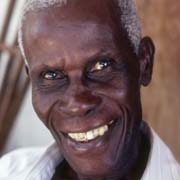
The Spaniards exploited the island for its gold, mined chiefly by local Amerindians directed by the Spanish occupiers. Those refusing to work in the mines were slaughtered or forced into slavery. Europeans brought chronic infectious diseases with them to which the Taíno had no natural immunity; the first recorded smallpox outbreak in the Americas occurred in 1507 when Spaniards brought the disease to Hispaniola. Death from diseases, combined with ill-treatment, malnutrition and a drastic drop in the birthrate, caused a rapid reduction of the indigenous population. On the authority of King Charles V, the Spanish governors then began importing enslaved Africans for labour. The Taínos became virtually, but not wholly extinct on the island of Hispaniola. Some who evaded capture fled to the mountains and established independent settlements. These survivors mixed with escaped African slaves (runaways called maroons) and produced a multiracial generation called Zambos. French settlers later called people of mixed African and Amerindian ancestry Marabou. The mestizo increased in number from children born to relationships between native women and European men. Others were born due to unions between African women and European men, called mulâtre in French.

The western part of Hispaniola soon was settled by French buccaneers. Bertrand D’Ogeron succeeded in growing tobacco, which prompted many other buccaneers and freebooters to turn into settlers. Bertrand D’Ogeron attracted many colonists from Martinique and Guadeloupe, where there were already sugar plantations. This population did not submit to Spanish royal authority until the year 1660, which caused several conflicts. France and Spain settled hostilities on the island by the Treaty of Ryswick of 1697, dividing Hispaniola. France received the western third and subsequently named it Saint-Domingue. Many French colonists soon arrived and established plantations in Saint-Domingue: from 1713 to 1787, approximately 30,000 colonists emigrated from Bordeaux, France, to the western part of the island. By about 1790, Saint-Domingue had greatly overshadowed its eastern counterpart in terms of wealth and population. It quickly became the most prosperous French colony in the New World due to the immense profits from the sugar, coffee and indigo industries. The labour and knowledge of thousands of enslaved Africans, who brought skills and technology for indigo production to the island, made it possible. The French-enacted Code Noir (Black Code), ratified by French King Louis XIV, established rigid rules on slave treatment and permissible freedom. It has been described as one of the most brutally efficient slave colonies ever - a third of new arrivals died within a few years.
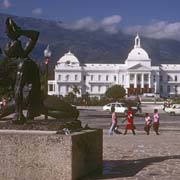
The French Revolution contributed to social upheavals in Saint-Domingue and the French and West Indies. Most important was the revolution of slaves in Saint-Domingue, starting on the northern plains in 1791. In 1792 the French government sent three commissioners with troops to reestablish control, building an alliance with “gens de couleur” (People of colour), looking for their rights. In 1793 France and Great Britain went to war, with the British troops invading Saint-Domingue. The same year, Louis XVI was executed. Under pressure, the French commissioners abolished slavery in the colony; six months later, the National Convention endorsed abolition and extended it to all French colonies. Toussaint L’Ouverture (20 May 1743 – 8 April 1803) was a leader of the Haitian Revolution. He led enslaved Africans to victory over Europeans, abolished slavery, and in 1797 secured native control over Haiti while nominally governor of the colony. He expelled the French commissioner Léger-Félicité Sonthonax and the British armies before invading Santo Domingo to free the slaves. He then wrote a separatist constitution naming himself governor-for-life that established a new policy for the colony.
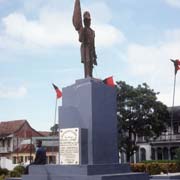
After Toussaint L’Ouverture had created a separatist constitution, Napoleon Bonaparte sent an expedition of 30,000 men under the command of his brother-in-law, General Charles Leclerc, to retake the island. Leclerc's mission was to oust L'Ouverture and restore slavery. The French did achieve some victories, and Leclerc invited Toussaint to a hearing, kidnapped him and sent him to France, where he was imprisoned at Fort de Joux. He died there in 1803 of exposure and tuberculosis or malnutrition and pneumonia. Especially between the years 1800 and 1802, Toussaint L’Ouverture had tried to rebuild the collapsed economy of Haiti and reestablish commercial contacts with the United States and Britain. His rule permitted the colony a taste of freedom which was gradually destroyed during successive reigns of a series of despots after his death in exile. In Haiti, the native leader Jean-Jacques Dessalines, long an ally of Toussaint L’Ouverture, defeated the French troops at the Battle of Vertières. At the end of this double battle for both their emancipation and independence, the former slaves proclaimed the independence of Saint-Domingue on 1 January 1804, naming the new nation “Haiti”, honouring one of the indigenous Taíno names for the island. Beginning as Governor-General, Dessalines later named himself Emperor Jacques I of Haiti. He exiled or killed the remaining whites and ruled as a despot enforcing a harsh regime of plantation labour.

Disaffected members of Dessalines’ administration, including Créole mulattoes Alexandre Pétion and Henri Christophe, began a conspiracy to overthrow the Emperor. Dessalines was assassinated north of the capital city, Port-au-Prince, at Pont Larnage (now known as Pont-Rouge) on 17 October 1806 on his way to fight the rebels. The country was divided between a kingdom in the north directed by Henri Christophe (28 December 1806 - 8 October 1820) and a republic in the south directed by Alexandre Pétion (10 March 1807 - 29 March 1818). Henri Christophe is best known for constructing the Citadelle Laferrière, the largest fortress in the Western Hemisphere, to defend the island against the French. Despite his efforts to promote education and establish the Code Henri legal system, King Henri was an unpopular autocratic monarch. In addition, his realm was constantly challenged by that of the south, which was ruled by “gens de couleur”. Towards the end of Christophe’s reign, public sentiment was firmly against what many perceived to be his feudal policies, with which he intended to develop the country. Ill and infirm at age fifty-three, King Henri shot himself with a silver bullet rather than face the possibility of a coup on 8 October 1820. He was buried within the Citadelle Laferriere.
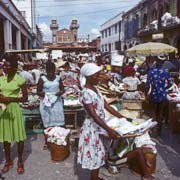
President Jean Pierre Boyer, also one of the “gens de couleur”, reunified Haiti’s two halves and extended control over the western part of the island. In February 1822, Jean-Pierre Boyer annexed the Spanish part of the island (the present-day Dominican Republic). A few months earlier, on 30 November 1821, it had proclaimed its independence from Spain under the name of “Republica del Haiti Español” (Spanish Republic of Haiti) and declared its alliance with Colombia. The flag of the Spanish Republic of Haiti was raised in the early weeks of 1822, but Boyer soon dissolved the new Republic. In July 1825, the King of France, Charles X, sent a fleet of fourteen vessels and troops to reconquer the island. To maintain independence, President Boyer agreed to a treaty by which France recognised the country’s independence in exchange for a payment of 150 million francs (the sum was reduced in 1838 to 90 million francs) - an indemnity for profits lost from the slave trade! A long succession of coups followed the departure of Jean-Pierre Boyer. National authority was disputed by factions of the army, the elite class and the growing commercial class, now made up of numerous immigrants: Germans, Americans, French and English.
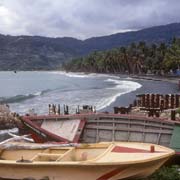
Expatriates bankrolled and armed opposing groups. In 1888 US Marines supported a military revolt against the government. In 1912 Syrians residing in Haiti participated in a plot in which the presidential palace was destroyed. In January 1914, British, German and United States forces entered Haiti ostensibly to protect their citizens. The United States occupied the island from 1915 to 1934. The administration dismantled the constitutional system, re-instituted virtual slavery for building roads, and established the National Guards that ran the countries after the Marines left. Then Dr François Duvalier, known as “Papa Doc”, was President of Haiti from 1957 to 1971. In 1964 he announced himself “President for Life”. Papa Doc ruled a regime marked by autocracy, corruption, and state-sponsored terrorism until his death through his private militia known as Tonton Macoutes. It has been estimated that he was responsible for 30,000 deaths and the exile of thousands more. His son Jean-Claude Duvalier (nicknamed “Bébé Doc” or Baby Doc, born 3 July 1951) succeeded his father in 1971 until he was overthrown by a popular uprising in 1986. The US arranged for Duvalier and his family to be exiled to France. Army leader General Henri Namphy headed a new National Governing Council. In March 1987, a new Constitution was overwhelmingly approved by the population. General elections in November were aborted hours after dozens were shot by soldiers and the Tonton Macoute in the capital and scores more around the country.
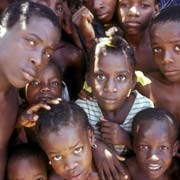
IIn December 1990, the former priest Jean-Bertrand Aristide won the election by more than two-thirds of the vote. His mandate began on 7 February 1991. But, following a coup d’etat in September 1991, President Aristide was flown into exile. Chaos ruled until 1994 when Haitian General Raoul Cédras asked the US to intervene. American forces entered the country in “Operation Uphold Democracy”, ousting the military and paving the way for the restoration of Jean-Bertrand Aristide as president. Aristide left the presidency in 1995 but was re-elected in 2000. Accusations of corruption marked his second term. In 2004 a paramilitary coup ousted Aristide a second time. Aristide was then removed by US Marines from his home in what he described as a “kidnapping” and briefly held by the government of the Central African Republic, to which the US had decided to fly him. Aristide obtained his release and returned to the western hemisphere shortly afterwards, although he did not return to Haiti. In February 2006, following elections marked by uncertainties and popular demonstrations, René Préval (close to the still-popular Aristide and former president of the Republic of Haiti between 1995 and 2000) was elected. There was optimism in Haiti, but then, a magnitude 7.0 earthquake near Port-au-Prince devastated the country on 12 January 2010, with over 150,000 feared dead in the capital alone.
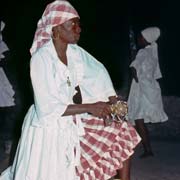
In 2017 Jovenel Moïse was sworn in as president, but protests and demonstrations in cities throughout the country started the following year when fuel prices rose. These evolved into demands for the president to resign. On 7 July 2021, President Moïse was assassinated, and the country descended into further chaos. On 14 August 2021, a magnitude 7.2 earthquake struck the southwestern peninsula of Haiti, causing massive damage and killing at least 2,200 people. It was followed by Hurricane Grace two days later with torrential rain and floods, hampering rescue efforts. Scores of Haitians now try to leave and go to the United States. Gangs roam the country, kidnapping for ransom, as there are no jobs. Haitian officials again asked the United States to send troops to stabilise this, the poorest country in the western hemisphere. The photos on these pages are from 1980 when life (under Baby Doc) didn’t seem as desperate as nowadays.


